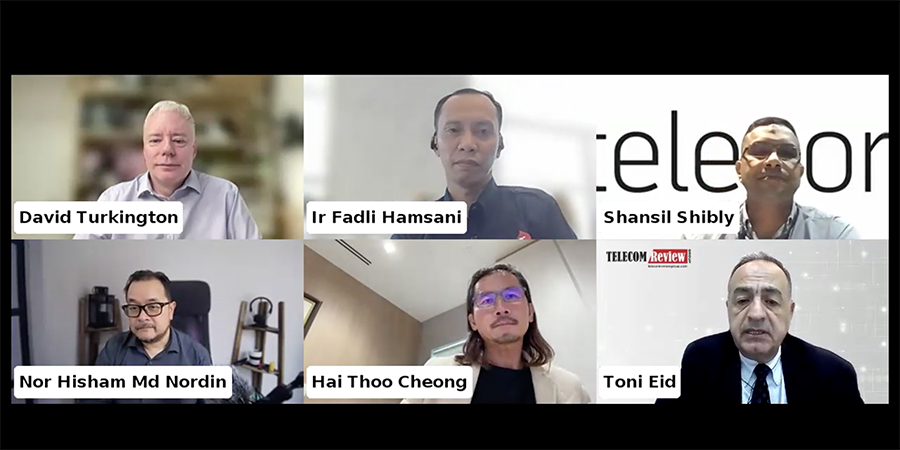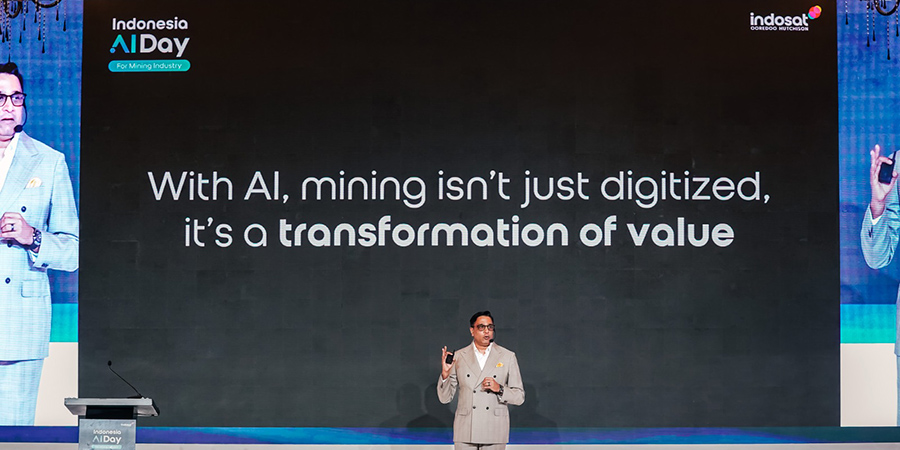Telecom Review, the Asia-Pacific’s leading ICT platform, under its parent company, Trace Media International, organized a webinar entitled, “Unleashing Network Capabilities with 5G-Advanced, Asia Edition,” held on April 29, 2024. The groundbreaking webinar was hosted by Telecom Review Group’s CEO, Toni Eid, and moderated by David Turkington, Head of Technology for GSMA Asia Pacific. The webinar brought together industry leaders to explore the transformative potential of 5G-Advanced (5.5G) in Asia.
Led by industry experts such as Shanshil Shibly, Asia Technology Head of Telenor Asia; Ir Fadli Hamsani, GM Enterprise Solution Management of Telkomsel; Nor Hisham Md Nordin, GM Mobile and Wireless of TM One; and Cheong Hai Thoo, Vice President Mobile Engineering of Singtel; the webinar covered a wide range of topics including industry-specific use cases, technological advancements, deployment strategies, and the socioeconomic impact of 5G-Advanced in Asia.
Transition Towards 5G-Advanced
The panelists provided insights into their companies’ journeys and discussed their notable initiatives within the realm of 5G. Hamsani recounted Telkomsel’s journey, highlighting the company’s 5G demo in May 2017 and impactful trials during the 2018 Asian Games, leading to the official launch of 5G in May 2020. These use cases targeted consumer and enterprise markets, particularly sectors like mining, manufacturing, and agriculture.
Meanwhile, Hai Thoo highlighted Singtel’s early 5G adoption, achieving nationwide coverage by July 2022. Singtel pioneered network slicing during the Formula One Singapore Grand Prix in October 2022, with subsequent enhancements including security slicing and application-based slicing, reinforcing their commitment to advancing network capabilities. Hai Thoo also mentioned the role of URSP obligation detection in February 2024. This accentuates the ongoing efforts Singtel is taking to enhance security protocols and compliance measures.
Additionally, Nordin shared TM One’s journey, highlighting collaborative efforts dating back to 2019, and the establishment of the DNB special purpose vehicle (SPV), which played an instrumental role in accelerating nationwide 5G deployment. Private 5G deployments for patrons demonstrated significant cost savings and enhanced safety in hazardous environments, laying the foundation for broader public adoption.
Furthermore, Shibly emphasized the challenges faced by Telenor Asia in adopting 5G, despite significant network coverage across Thailand. Drawing inspiration from Nordic counterparts’ advancements in 5.5G, Telenor Asia aims to leverage advanced capabilities to drive enterprise success in Asia.
Key Features of 5G-Advanced Networks
When asked about the key features of 5G-Advanced networks, and how they differ from 4G and/or 5G networks, Shibly emphasized the evolutionary path from 4G to 5G, and now onto 5.5G, underlining the gradual transition driven by technology capabilities and business interests. Shibly highlighted the company’s focus on artificial intelligence (AI) and machine learning (ML), aligning with enterprise needs in sectors like manufacturing, mining, and port authority.
Hamsani echoed Shibly’s sentiments, stressing the shift towards business enterprise solutions and the pivotal role of 5G in addressing industry pain points.
Hai Thoo underscored the significance of low latency as a cornerstone feature of 5G-Advanced networks (essential for supporting latency-sensitive applications such as augmented reality (AR), virtual reality (VR), and real-time gaming). Additionally, he emphasized that high density, referring to the ability to accommodate a large number of connected devices within a confined area, is emerging as a key imperative for 5G-Advanced networks.
Another pivotal aspect highlighted by Hai Thoo was the importance of network slicing in the context of 5G-Advanced networks. Moreover, the focus on uplink speed over downlink speed signifies a strategic shift towards prioritizing symmetrical data transmission, particularly relevant for applications requiring high upstream bandwidth such as video conferencing, cloud gaming, and remote collaboration. The integration of AI and ML further augments the efficacy of network slicing, enabling intelligent resource allocation and dynamic traffic management.
Tech, Spectrum and Regulatory Considerations when Transitioning From 5G to 5G-Advanced
When asked about the network and tech requirements needed for the transition from 5G to 5G-Advanced, Hai Thoo highlighted the regulatory framework set by the IMDA, emphasizing the importance of a standalone 5G network as the foundation for both 5G and its advanced iteration. He noted that the evolution from 5G to 5G-Advanced is a natural progression, primarily driven by market demand. Despite significant investments in 5G infrastructure, Hai Thoo observed a lack of new applications demanding high bandwidth and low latency.
However, he expressed optimism about emerging demands from enterprises for guaranteed quality of service. Hai Thoo highlighted enhancements in 5G-Advanced, such as improved radio performance, enhanced coverage, support for passive IoT, and increased efficiency through AI and ML technologies. He also emphasized the importance of aligning these enhancements with specific use cases to ensure effective solutions without creating unnecessary problems. He added that the integration of Multiple Input Multiple Output (MIMO) technologies and passive IoT solutions are emerging as key enablers of network efficiencies and performance optimization.
Nordin emphasized the critical role of spectrum allocation in facilitating the transition to 5G-Advanced networks. Specifically, he noted that the utilization of C-Band and high throughput frequencies is emerging as a cornerstone strategy to unlock enhanced network performance and capacity. The advocacy for leveraging the 17-18 gigahertz spectrum underscores the imperative of tapping into higher frequency bands to accommodate growing data demands and enable future innovations.
Furthermore, Nordin highlighted the significance of considering RAN vendor differences and ensuring compatibility across end-to-end core and RAN infrastructure. In addition to spectrum considerations, Nordin underscored the importance of integrating green technology solutions to promote sustainability and environmental stewardship.
Successful 5G-Advanced Deployments in Asia and Their Challenges
When asked about successful 5G-Advanced deployments in Asia and the challenges faced, Hamsani mentioned the importance of learning from past experiences in 5G deployment. He highlighted key challenges such as the maturity of the device ecosystem supporting 5G technology and the need to address issues within the network, device, and application ecosystem. Moreover, Hamsani highlighted the robust technical investment in Indonesia, where significant portions of the GDP are allocated to drive innovation and infrastructure development, further fueling the momentum towards 5G-Advanced adoption.
Meanwhile, Hai Thoo talked about the significant adoption of networks across various countries, achieving over 100% penetration and leveraging economies of scale. He further discussed the deployment of 5G-Advanced networks during events in Singapore featuring renowned artists like Taylor Swift and Bruno Mars, which showcased the transformative potential of advanced networking technologies in enhancing user experiences and enabling innovative applications. Through high-definition video streaming services and immersive multimedia experiences, attendees were able to enjoy split viewpoints and multiple angles, creating a truly immersive and interactive environment.
Hai Thoo highlighted the remarkable capacity of 5G-Advanced networks, which can accommodate high traffic loads with an average of 60-70 thousand people connected simultaneously during peak periods. He noted that this seamless connectivity and low-latency communication facilitates a wide range of activities, from real-time communication and social interaction to multimedia content consumption and sharing.
Through meticulous planning and leveraging advanced network slicing techniques, Singapore achieved unprecedented levels of connectivity and service quality, exemplifying an “economy of scope” where resources were optimized to deliver maximum value and performance.
Fueling Economic Growth Across Asian Industries
With a shared vision of leveraging advanced networking technologies to unlock new opportunities and propel innovation, the panelists emphasized the critical role of collaborative efforts in realizing the transformative potential of 5G-Advanced.
Shibly emphasized the rapid evolution of the ecosystem, sharing the imperative for collaboration with hyperscale companies and industries transitioning towards AR and VR technologies. He stressed the pivotal role of CSPs in effectively delivering these services to customers, thereby advancing 5G and potentially paving the way for the transition to 6G.
The moderator, David Turkington, interjected, reiterating the importance of uplink capabilities and emphasizing its critical role in ensuring seamless connectivity and optimal performance, particularly in applications requiring real-time data transmission and interaction.
Nordin, on the other hand, discussed the benefits and challenges of 5G and 5G-Advanced deployments, particularly in private networks. He emphasized the need for a cost-benefit analysis, highlighting industries such as oil and gas, manufacturing, ports, and mining as prime candidates for private network adoption due to the specific requirements and remote locations involved. Additionally, delving into TM One’s spectrum allocation challenges, Nordin highlighted the significance of private networks tailored to specific industry requirements, citing LTE as a focal point for enhancing connectivity and reliability, especially in environments where traditional Wi-Fi solutions may prove inadequate.
Hamsani underscored the importance of showcasing tangible use cases to demonstrate the value proposition of 5G-Advanced technologies and encourage investment. By leveraging AI, IoT, and VR technologies, industries such as mining and automotive have pioneered innovative solutions that optimize operations, enhance productivity, and drive efficiency.
The implementation of connected machines, sensors, automation, and logistics serve as compelling examples of the transformative impact of 5G-Advanced in enabling Industry 4.0 initiatives. Hamsani emphasized the concept of “seeing is believing,” highlighting the importance of tangible demonstrations to instill confidence and drive adoption among stakeholders. Furthermore, Hamsani’s notion outlining the “elastic customer” underscores the importance of agility and responsiveness in meeting evolving market demands, positioning 5G-Advanced as a catalyst for sustainable growth and competitiveness.
Spectrum Allocation: Key Considerations and Strategies
In terms of spectrum allocation and key 5G-Advanced considerations, Shibly emphasized the importance of spectrum efficiency and carrier aggregation in maximizing spectrum usage for 5G and 5G-Advanced. He also discussed the potential for spectrum reform and collaboration with regulators to optimize spectrum utilization.
Hai Thoo shifted the focus to Singapore’s approach, commending the country’s prioritization of network quality over revenue in spectrum allocation. He further highlighted the indispensable role of spectrum bands like the mid-band and low-band in constructing high-quality 5G networks pivotal for economic growth and innovation. Hai Thoo also emphasized the strategic imperative of securing adequate frequencies to support the rollout of 5G-Advanced networks, ensuring optimal performance and coverage.
Nordin outlined the key technological considerations and challenges in deploying 5G-Advanced networks, emphasizing the need to transition from private to public networks and optimize spectrum usage. While mid- to C-Band frequencies offer promising opportunities for 5G deployment, he emphasized that challenges related to mmWave propagation in areas with thick vegetation highlight the importance of adapting deployment strategies to local conditions.
Moreover, Nordin highlighted the importance of addressing gaps in the device ecosystem and implementing dual-network solutions to enhance coverage and reliability.
Shibly further underscored the importance of maximizing spectrum usage and exploring opportunities in the 6 GHz frequency band to support future iterations of 5G technology. He emphasized that reform initiatives aimed at streamlining regulatory processes and promoting efficient spectrum management are essential to realizing the full potential of 5G-Advanced networks.
The Power of Regional Collaboration
As the webinar came to a close, the discourse turned to the importance of regional partnerships. Shibly underscored the strength of Telenor Asia’s alliances with major OEMs such as Ericsson, Nokia, ZTE, and Huawei. He stressed the pivotal role of collaboration in propelling network advancements and maximizing the potential of cloud platforms for various applications. He noted that the involvement of hyperscale cloud providers signifies the convergence of telecommunications and cloud computing ecosystems, facilitating the integration of advanced services and applications.
Hai Thoo echoed this sentiment, emphasizing the significance of collaboration among service providers across the region. He mentioned key players like AIS in Thailand, Telkomsel in Indonesia, Optus in Australia, Globe in the Philippines, and others, once again, noting the importance of sharing experiences and expertise to promote 5G adoption across diverse environments and use cases.
Moving forward, continued collaboration will be essential for promoting 5G adoption across various environments and use cases, ensuring the seamless integration and advancement of telecommunications technologies throughout the region.
As the journey towards realizing the full potential of 5G continues, continued dialogue, strategic partnerships, and proactive problem-solving will be essential for overcoming challenges and maximizing the opportunities that lie ahead.







